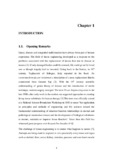Please use this identifier to cite or link to this item:
http://archive.nnl.gov.np:8080/handle/123456789/358Full metadata record
| DC Field | Value | Language |
|---|---|---|
| dc.contributor.author | Joshi, Mahesh Kumar | |
| dc.date.accessioned | 2019-03-27T08:37:56Z | |
| dc.date.accessioned | 2020-08-21T07:33:38Z | - |
| dc.date.available | 2019-03-27T08:37:56Z | |
| dc.date.available | 2020-08-21T07:33:38Z | - |
| dc.date.issued | 2019-03-27 | |
| dc.identifier.uri | http://103.69.125.248:8080/xmlui/handle/123456789/358 | - |
| dc.description.abstract | In the past decade, considerable efforts have been made to fabricate the biomimetic scaffolds from electrospun nanofibers for tissue engineering applications.Electrospinning technique offers unique advantages in the production of tissue engineering scaffolds compared to other methods in terms of simplicity, high surface-to-volume ratio scaffolds and process versatility. As promising as it may seem, this technology is still in its infancy, and further development is critical before it can be used for any practical biomedical applications. One of the major concerns with electrospunnanofibrous scaffolds is that they have only a superficially porous network, resulting in a sheet-like two-dimensional (2D) framework that restricts cell infiltration and growth. Moving towards the next generation of electrospun scaffolds, increasing research efforts are being focused on issues such as three-dimensionality, bio-functionalization, and improved biomechanical properties of the scaffolds. | en_US |
| dc.language.iso | en_US | en_US |
| dc.subject | Electrospinning; 3D Scaffolds; tissue engineering; post electrospinning process; gas foaming; alkaline saponification | en_US |
| dc.title | Fabrication and Characterization of Three-Dimensional Nano-Fibrous Scaffolds for Tissue Engineering Applications February 22, | en_US |
| dc.type | Thesis | en_US |
| Appears in Collections: | 500 Natural sciences and mathematics | |
Files in This Item:
| File | Description | Size | Format | |
|---|---|---|---|---|
| Thesis Part 1 .pdf | 110.84 kB | Adobe PDF |  View/Open | |
| Thesis Part 2 .pdf | 299.47 kB | Adobe PDF |  View/Open | |
| Thesis Part 3 .pdf | 5.45 MB | Adobe PDF |  View/Open |
Items in DSpace are protected by copyright, with all rights reserved, unless otherwise indicated.